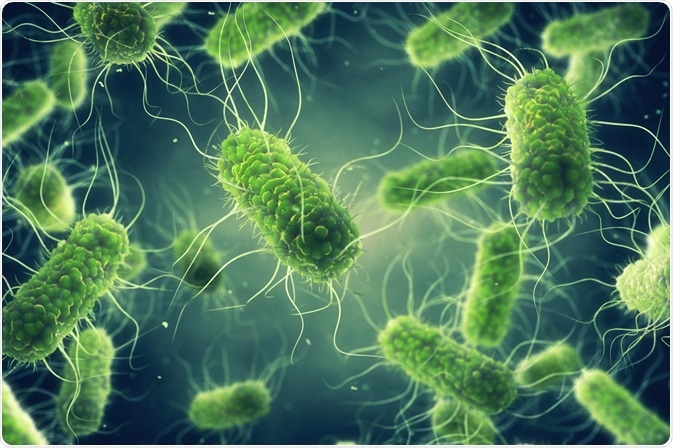Salmonellae are motile, Gram-negative bacilli that can infect or colonize a wide range of mammalian hosts. Since its discovery, these bacteria fascinated the medical community, primarily because of the antigenic diversity within the genus, which led to the assignment of isolates to more than 2500 different serovars.
The inception of Salmonella genetics can be traced back to the discoveries and descriptions of remarkable phenomena of antigenic variation in this genus. The second epoch came with the success in the transfer of the fertility factor from E. coli to Salmonella and the hybrid formation between them, which has been used for constructing the chromosome map of this microorganism.

Image Credit: nobeastsofierce / Shutterstock
Core genome and mobile elements
All strains of salmonellae have a single chromosome (approximately 4.5 Mb in size) with a set of core genes that perform “household” functions associated with the lifestyle of intestinal colonization and environmental survival. Those genes can also have a role in central metabolism, polysaccharide biosynthesis, or may encode common structural proteins.
Scattered along the core genome are blocks of genes (or even single genes in some cases) that show limited or no homology with the core genome. Often referred to as “pathogenicity islands”, those genes have different guanine-cytosine content when compared to the core genome and act to enhance the virulence potential of a species as a whole.
Different strains of Salmonella may also harbor extrachromosomal DNA in the form of plasmids. They are part of the flexible genome, defined by the high plasticity and modularity of its genetic elements. Plasmids often carry genes associated with virulence or antibiotic resistance, and are classified according to the incompatibility groups (based on the inability of similar plasmids to co-exist in the same cell).
Bacteriophages or bacterial viruses, which can mobilize DNA, appear to be one of the critical drivers of diversity in these microorganisms. Low molecular weight multi-copy plasmids are ubiquitous in Salmonella and some of them have been shown to increase resistance to bacteriophage infections due to the presence of modification systems.
Complex interactions among pathogenicity islands, bacteriophages, plasmids and other mobile elements are increasingly being observed in the Salmonella genus. Separation of the core and variant genes resulted in a fundamental biological insight into the genetic basis of phenotypic similarity and diversity of this pathogen.
Antimicrobial resistance
The resistance genes found in Salmonella are closely related or even indistinguishable from those found in other bacteria. Problems caused by the increasing resistance include not only apparent difficulties in antimicrobial therapy but also the predilection of the organism to cause serious diseases.
A dominant reason for the higher antimicrobial resistance observed in Salmonella Typhimurium is the emergence of a distinct multidrug-resistant strain of definitive phage type 104 (DT104) Salmonella Typhimurium in the USA and Europe in the last decade of the previous century. Furthermore, hybrid virulence-resistance plasmids have been isolated in serovars Typhimurium, Enteritidis and Choleraesuis that have been found in Italy, Spain, Taiwan, Czech Republic and the United Kingdom.
An investigation of the molecular evolution of multi-resistance in nontyphoid salmonellae has shown that progressive acquisition and accumulation of plasmid-mediated resistance determinants arose as a result of the exchange of plasmids and other mobile elements between Salmonella and other members of the family Enterobacteriaceae.
Genotypic and sequence-based typing
Genetic typing methods of salmonellae are based on molecular tools and can be divided into the chromosomal analysis (ribotyping, IS200 typing and macrorestriction of genomic DNA by pulsed-field gel electrophoresis typing) and extrachromosomal analysis (plasmid profiling and restriction digest of plasmids).
The use of pulsed-field gel electrophoresis (PFGE) has become the gold standard for mutual comparison of different isolates that can be used internationally, primarily due to the substantial progress in standardization of methods. In addition, the typing data can be stored in silico as reference material or for any further comparison.
Plasmid profiling has its use in subtyping Salmonella during outbreak investigations. As a simple comparison of plasmid profiles can sometimes be misleading, isolates are often further discriminated by restriction digests of the apparently similar plasmids. It is important to note that strains may contain more than one plasmid species of the same size.
Sequence-based typing schemes can also be considered as classification schemes, thus genetic and even evolutionary inferences can be made. Contemporary DNA-sequence-based typing techniques encompass the detection of DNA repeats and single nucleotide polymorphisms. The variable number of tandem repeat variation (VNTR) gives data on the copy number of short repetitive sequences of individual isolates.
Sources
- https://www.caister.com/
- www.ojvr.org/index.php/ojvr/article/view/807/1147
- http://www.jidc.org/index.php/journal/article/view/23324813
- https://academic.oup.com/cid
- journals.plos.org/plosone/article?id=10.1371/journal.pone.0095976
- Iino T, Lederberg J. Genetics of Salmonella. In: Van Oye E. The World Problem of Salmonellosis. Springer Science & Business Media, 2013; pp. 111-141.
- Morgan E. Salmonella Pathogenicity Islands. In: Rhen M. Salmonella – Molecular Biology and Pathogenesis. Horizon Scientific Press, 2007; pp. 67-88.
Further Reading
Last Updated: Apr 7, 2023